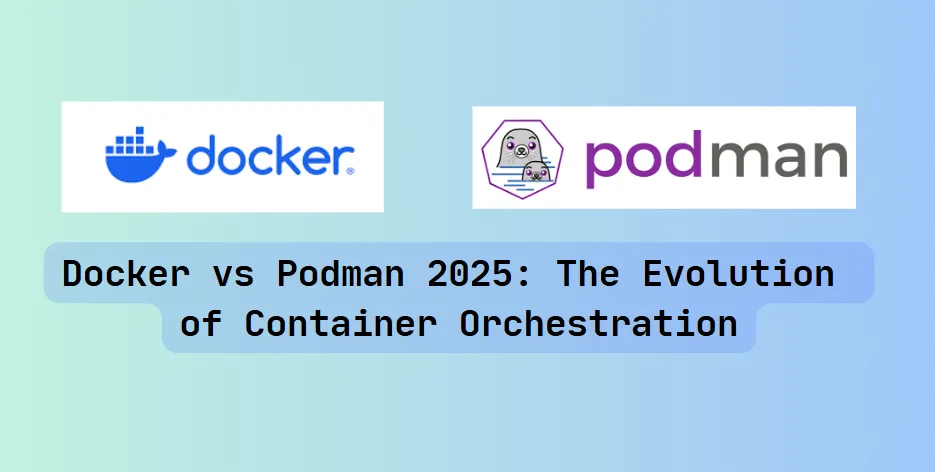Since its beginning, container orchestration has come a long way. Organizing containerized workloads in the fast-paced development environment of today requires striking a balance between security, flexibility, and performance in addition to automation. In this article, we’ll be comparing the newest features of Docker and Podman and look at how they have adjusted to the shifting DevOps landscape in 2025 as we delve into the ongoing development of container orchestration tools.
What is Container Orchestration?
Container orchestration is the process of automating the deployment, management, scaling, and networking of containers throughout their lifecycle, making it possible to deploy software consistently across many different environments at scale.
Containers, which package an application and its runtime environment together in a self-contained unit, are foundational to cloud native application development. Container orchestration is especially important for enterprises that need to deploy and manage hundreds or thousands of containers and hosts. Most container orchestration solutions are built on Kubernetes, a widely adopted open source platform. Source
The Docker Legacy: Then and Now
Docker needs no introduction — it’s been the go-to container engine for developers worldwide for a long time. Even in 2025, Docker remains popular thanks to:
Integrated Tools: Docker continues to support a comprehensive suite of tools for building, testing, and running containers. Though Docker Swarm once provided native clustering capabilities, many developers have now transitioned to Kubernetes for large-scale orchestration.
Evolving Security: With the ever-increasing focus on cybersecurity, Docker has enhanced its rootless container options. This evolution minimizes risk by reducing the need for privileged operations.
Cross-Platform Adaptability: Docker’s mature ecosystem guarantees consistency whether you’re developing on Linux, Windows, or macOS. Recent improvements further streamline cross-platform deployments, making Docker a reliable choice for hybrid cloud environments.
Enter Podman: The Daemon-less Contender
Podman has steadily gained traction among developers who value its innovative approach to container management. In 2025, Podman continues to impress with several key features:
Daemon-less Architecture: Unlike Docker, which relies on a long-running daemon, Podman creates containers as child processes of the invoking user. This design inherently reduces security risks by limiting unnecessary privileges.
Modular Toolchain: In its ecosystem, Podman is complemented by specialized utilities such as Buildah for building images, Skopeo for image inspection, and crun for runtime flexibility. This modularity gives developers the freedom to swap or upgrade components without overhauling the entire workflow.
Seamless Integration: Podman’s compatibility with Docker’s CLI interface means that teams can transition smoothly or even use both tools simultaneously. This is particularly useful in environments where specific needs — like rootless operation or enhanced systemd integration are paramount.
Cloud-Native Ready: With the rapid adoption of microservices, Podman’s support for Kubernetes-like pods has allowed for more granular application management. This makes it easier to group related containers and manage them as a cohesive unit.
Key Differences Revisited
As we assess Docker and Podman in 2025, several differences stand out:
Architecture
Docker: Employs a client-server model with a central daemon responsible for container lifecycle management.
Podman: Operates daemon-less, leveraging Unix processes which translate to improved security and easier process-level management.
Privilege Management
Docker: Continues to offer rootless modes, but historically has required elevated privileges for its daemon-based operations.
Podman: Has built its identity around non-root operations, making it inherently safer when running multi-tenant or production workloads.
Security Considerations
Docker: Ongoing enhancements in its security model include sandboxing and better integration with modern security tools.
Podman: Its design reduces the attack surface by eliminating the need for a persistent daemon, a feature that remains a significant advantage in environments where security is a top concern.
Integration with System Management
Docker: Often relies on external solutions like Kubernetes or Docker Compose for service orchestration.
Podman: Leverages systemd natively — allowing containers to be managed as system services. This results in smoother deployments and easier handling of service restarts or dependencies.
Building and Modularity
Docker: Offers an all-in-one toolchain that simplifies container creation and management.
Podman: The separation of tasks (building with Buildah, inspecting with Skopeo, etc.) provides flexibility. Developers who prefer specialized tools for each step often find this approach beneficial, especially when fine-tuning performance and security.
Podman and Docker: Coexistence in a Modern Ecosystem
Despite their differences, Podman and Docker are not mutually exclusive. Many organizations can operate hybrid environments where:
Development uses Docker for its familiar interface and straightforward workflows.
Production leverages Podman’s robust security and integration with modern service managers like systemd.
This cooperative usage demonstrates that the choice between Docker and Podman need not be binary. Instead, it can be about selecting the right tool for the task at hand and, in some cases, integrating both to capitalize on their unique strengths.
Looking Ahead: The Future of Container Orchestration
As we progress through 2025, the demands on container orchestration continue to evolve. Both Docker and Podman are adapting to meet the challenges posed by increasingly sophisticated cloud-native environments. Key trends we anticipate include:
Enhanced Security Protocols: Continuous advancements in rootless architectures and secure defaults will drive improvements in container security.
Greater Modularity and Interoperability: The future of container tooling lies in blending specialized utilities with robust orchestration frameworks. This modular approach promises easier updates and better performance tuning.
Integration with Serverless Architectures: As serverless solutions rise in popularity, both Docker and Podman will likely evolve to interface seamlessly with these systems, bridging the gap between containers and ephemeral compute resources.
Final Thoughts
Both Docker and Podman have carved their niches in the container orchestration landscape. Docker’s widespread adoption and user-friendly tooling are complemented by Podman’s focus on security, daemon-less operation, and modularity. In 2025, the key is to understand your project’s unique needs — whether you prefer an all-in-one solution or a combination that leverages the strengths of both tools.
Thanks for reading, and stay tuned as we continue to explore the evolving world of container technology. Until next time, keep learning and stay secure!
